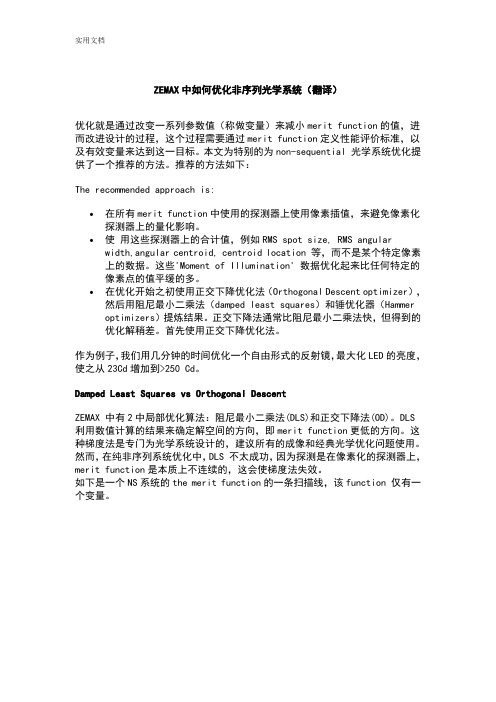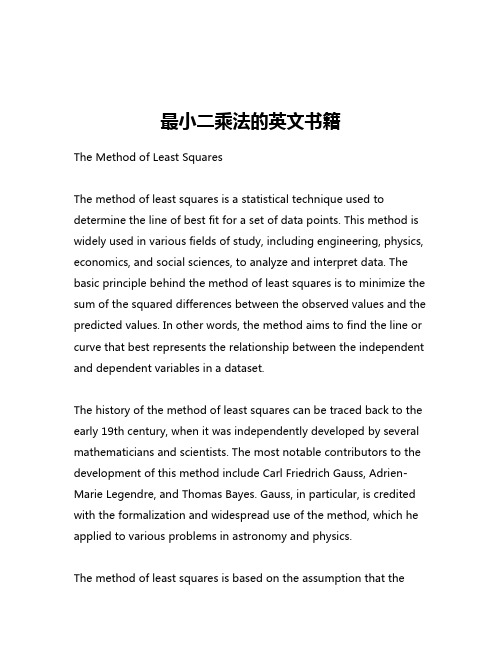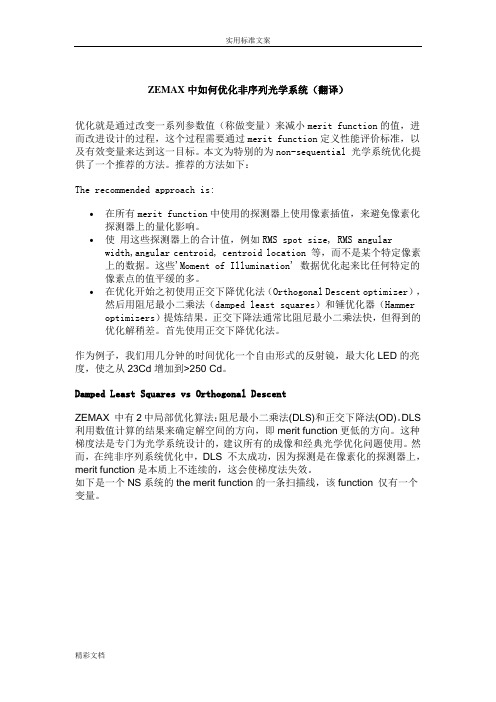Solution of the damped least-squares problem by
- 格式:pdf
- 大小:280.38 KB
- 文档页数:3

least-squares estimates 表示方法Leastsquares Estimates 表示方法在统计学中,leastsquares estimates(最小二乘估计)是一种常用的参数估计方法,用于找到使得观测数据和预测值之间残差平方和最小的参数估计值。
这种估计方法是基于最小化误差平方和的思想,以使得观测数据和预测值之间的差异最小化。
本文将详细介绍leastsquares estimates的表示方法,并逐步回答和解释相关的主题。
我们将从最基础的概念开始,然后深入探讨该方法的数学推导和实际应用。
第一部分:最小二乘估计基础最小二乘估计最早由数学家Carl Friedrich Gauss提出,并成为现代统计学的重要基础之一。
在这一部分,我们将介绍最小二乘估计的基本概念和步骤。
1.1 问题陈述首先,我们需要明确最小二乘估计的问题陈述。
假设我们有一组观测数据(x,y),我们的目标是找到一个函数y=f(x,θ),其中θ是待估计的参数,能够最小化观测值y 和预测值f(x,θ) 之间的残差平方和。
1.2 最小二乘估计的数学表达式最小二乘估计的数学表达式可以通过最小化残差平方和来表示。
对于给定的观测数据(x1,y1),(x2,y2),…,(xn,yn),最小化残差平方和可以表示为:min θ∑(yi - f(xi,θ))^2其中∑表示对所有观测数据求和。
1.3 最小二乘估计的步骤最小二乘估计的步骤可以总结如下:1. 根据给定的观测数据,选择一个适当的函数形式y=f(x,θ)。
2. 构建残差平方和的表达式,以对观测数据和参数进行求和。
3. 求解参数估计值θ,使得残差平方和最小化。
4. 检验参数估计值的有效性和可靠性。
第二部分:最小二乘估计的数学推导在这一部分,我们将深入探讨最小二乘估计的数学推导过程。
我们将解释如何求解最小二乘估计的参数值,并推导出最小二乘估计的统计性质。
2.1 求解参数估计值对于给定的函数形式y=f(x,θ),我们可以通过最小化残差平方和的导数等于零来求解参数估计值。

ZEMAX中如何优化非序列光学系统(翻译)优化就是通过改变一系列参数值(称做变量)来减小merit function的值,进而改进设计的过程,这个过程需要通过merit function定义性能评价标准,以及有效变量来达到这一目标。
本文为特别的为non-sequential 光学系统优化提供了一个推荐的方法。
推荐的方法如下:The recommended approach is:•在所有merit function中使用的探测器上使用像素插值,来避免像素化探测器上的量化影响。
•使用这些探测器上的合计值,例如RMS spot size, RMS angular width,angular centroid, centroid location 等,而不是某个特定像素上的数据。
这些'Moment of Illumination' 数据优化起来比任何特定的像素点的值平缓的多。
•在优化开始之初使用正交下降优化法(Orthogonal Descent optimizer),然后用阻尼最小二乘法(damped least squares)和锤优化器(Hammeroptimizers)提炼结果。
正交下降法通常比阻尼最小二乘法快,但得到的优化解稍差。
首先使用正交下降优化法。
作为例子,我们用几分钟的时间优化一个自由形式的反射镜,最大化LED的亮度,使之从23Cd增加到>250 Cd。
Damped Least Squares vs Orthogonal DescentZEMAX 中有2中局部优化算法:阻尼最小二乘法(DLS)和正交下降法(OD)。
DLS 利用数值计算的结果来确定解空间的方向,即merit function更低的方向。
这种梯度法是专门为光学系统设计的,建议所有的成像和经典光学优化问题使用。
然而,在纯非序列系统优化中,DLS 不太成功,因为探测是在像素化的探测器上,merit function是本质上不连续的,这会使梯度法失效。

最小二乘法的英文书籍The Method of Least SquaresThe method of least squares is a statistical technique used to determine the line of best fit for a set of data points. This method is widely used in various fields of study, including engineering, physics, economics, and social sciences, to analyze and interpret data. The basic principle behind the method of least squares is to minimize the sum of the squared differences between the observed values and the predicted values. In other words, the method aims to find the line or curve that best represents the relationship between the independent and dependent variables in a dataset.The history of the method of least squares can be traced back to the early 19th century, when it was independently developed by several mathematicians and scientists. The most notable contributors to the development of this method include Carl Friedrich Gauss, Adrien-Marie Legendre, and Thomas Bayes. Gauss, in particular, is credited with the formalization and widespread use of the method, which he applied to various problems in astronomy and physics.The method of least squares is based on the assumption that theerrors or deviations between the observed values and the predicted values are normally distributed, with a mean of zero and a constant variance. This assumption is known as the Gauss-Markov assumption, and it is crucial for the validity of the method's statistical properties.The process of applying the method of least squares involves the following steps:1. Identify the independent and dependent variables: The first step in using the method of least squares is to identify the variables that are being studied. The independent variable (or variables) is the factor that is being manipulated or controlled, while the dependent variable is the outcome or response that is being measured.2. Collect the data: Once the variables have been identified, the next step is to collect the data. This typically involves measuring the values of the independent and dependent variables for a set of observations or data points.3. Fit the line of best fit: The method of least squares is used to determine the line or curve that best fits the data. This is done by minimizing the sum of the squared differences between the observed values and the predicted values. The resulting line or curve is known as the line of best fit or the regression line.4. Interpret the results: After the line of best fit has been determined, the next step is to interpret the results. This may involve calculating the slope and intercept of the line, as well as the goodness of fit, which measures how well the line of best fit represents the data.The method of least squares has several important properties that make it a powerful tool for data analysis. First, the method is unbiased, meaning that the predicted values are, on average, equal to the true values. Second, the method is efficient, in the sense that it produces the smallest possible variance of the predicted values. Finally, the method is consistent, which means that as the number of data points increases, the predicted values converge to the true values.Despite its many advantages, the method of least squares also has some limitations. For example, the method assumes that the errors are normally distributed and have constant variance, which may not always be the case in real-world data. Additionally, the method is sensitive to outliers, which can have a significant impact on the resulting line of best fit.In recent years, the method of least squares has been extended and refined to address some of these limitations. For example, robust regression techniques have been developed to deal with outliers, while Bayesian methods have been used to incorporate priorinformation into the analysis.Overall, the method of least squares is a powerful and widely used tool for data analysis. Its ability to identify the line or curve that best represents the relationship between variables makes it an essential tool in a wide range of scientific and mathematical disciplines.。

Least squares problemsIntroductionA standard technique in mathematical and statistical modeling is to find a least squares fit to a set of data points in the plane.The technique of least squares was developed independently by Adrien-Marie Legendre in 1806and Carl Friedrich Gauss in 1797.A least squares problem can generally be formulated as an overdetermined linear system of equations (involving more equations than unknowns). Such systems are usually inconsistent.Introduction (continued)In this section we will define the least squares solution for an overdetermined linear system.We will discuss its existence and uniqueness and study how to solve a least squares problem.And we will show examples.Outline1.Definition of least squares solution2.Existence and uniqueness of the closest vector3.Solving least squares problem4.ExamplesLeast squares solutions of overdetermined systemsBy definition, if is a least squares solution of the systemAx = b and p = A , xx then p is a vector in the column space The next theorem guarantees that such a closest vector p not only exists, but is unique.of A that is closest to b .How to find least squares solution?If is a least squares solution of the system Ax = b and p = A , then p is a vector in the column space of A that is closest to ly, p ∈R(A) = S, and So p is the projection of b onto R(A).xx b p R(A). A (b A x )=0,T A A x =A b.T TA T Ax = A T b, called the normal equationsN(A )=R(A)T ,Remark. We can get the least squares solution of the system Ax = b by solving the normal equations.R(A)p b-pbSolving least squares problemTh2 If A is an m ×n matrix of rank n , the normal equations A T Ax = A T b have a unique solution= (A T A)-1A T b and is the unique least squares solution of the system x xIf A T A is invertible Ax = b.Proof. Let z be a solution of A T Ax = 0, then A T Az = 0,z T A T Az =0, (Az)T (Az) =0,Az = 0. Rank(A) = n ,z = 0. So A T A is invertible.= (A T A)-1A T b, unique solution.xSolving least squares problem using projection matrix If A is an m ×n matrix of rank n , the normal equations A T Ax = A T b have a unique solution= (A T A)-1A T b and is the unique least squares solution of the system x xAx = b. p = A = A(A T A)-1A T b = P b.P = A(A T A)-1A T ,P 2= P, P T = P.Solving Ax = p =P b, we can find the unique least squares solution of the system Ax = b.x Remark.projection matrixEx2. Given the datax = 0, 3, 6y = 1, 4, 5Find the best least squares fit by a linear function.Solution. 01.y c c x 01101where A 13,c ,b 4.165 c c Then we have a linear system Ac = b:0 0 1 01 1,34,65,c c c c c Suppose the best linear fit function isThank you!。

ZEMAX中如何优化非序列光学系统(翻译)优化就是通过改变一系列参数值(称做变量)来减小merit function的值,进而改进设计的过程,这个过程需要通过merit function定义性能评价标准,以及有效变量来达到这一目标。
本文为特别的为non-sequential 光学系统优化提供了一个推荐的方法。
推荐的方法如下:The recommended approach is:∙在所有merit function中使用的探测器上使用像素插值,来避免像素化探测器上的量化影响。
∙使用这些探测器上的合计值,例如RMS spot size, RMS angular width,angular centroid, centroid location 等,而不是某个特定像素上的数据。
这些'Moment of Illumination' 数据优化起来比任何特定的像素点的值平缓的多。
∙在优化开始之初使用正交下降优化法(Orthogonal Descent optimizer),然后用阻尼最小二乘法(damped least squares)和锤优化器(Hammeroptimizers)提炼结果。
正交下降法通常比阻尼最小二乘法快,但得到的优化解稍差。
首先使用正交下降优化法。
作为例子,我们用几分钟的时间优化一个自由形式的反射镜,最大化LED的亮度,使之从23Cd增加到>250 Cd。
Damped Least Squares vs Orthogonal DescentZEMAX 中有2中局部优化算法:阻尼最小二乘法(DLS)和正交下降法(OD)。
DLS 利用数值计算的结果来确定解空间的方向,即merit function更低的方向。
这种梯度法是专门为光学系统设计的,建议所有的成像和经典光学优化问题使用。
然而,在纯非序列系统优化中,DLS 不太成功,因为探测是在像素化的探测器上,merit function是本质上不连续的,这会使梯度法失效。

六自由度机械臂轨迹规划及优化研究一、本文概述理论基础与问题阐述:本文将系统梳理六自由度机械臂的数学模型,包括其笛卡尔坐标系下的运动学逆解与正解、动力学建模,以及关节空间与操作空间之间的转换关系。
在此基础上,明确阐述轨迹规划与优化所面临的关键问题,如奇异位形规避、关节速度与加速度限制、路径平滑性要求、动态负载变化等因素对规划算法设计的影响。
轨迹规划方法:针对上述问题,我们将探讨和比较多种有效的轨迹规划策略。
这包括基于插值的连续路径生成方法(如样条曲线、Bzier曲线),基于优化的全局路径规划算法(如RRT、PRM等),以及考虑机械臂动力学特性的模型预测控制(MPC)方法。
对于每种方法,将详细分析其原理、优势、适用场景及可能存在的局限性,并通过实例演示其在典型任务中的应用效果。
轨迹优化技术:在基本轨迹规划的基础上,本文将进一步探究如何运用先进的优化算法对初始规划结果进行精细化调整,以达到性能最优。
这包括使用二次规划、非线性优化、遗传算法等手段对轨迹的关节角序列、时间参数化、能量消耗等指标进行优化。
还将讨论如何引入避障约束、柔顺控制策略以及自适应调整机制,以增强机械臂在复杂环境和不确定条件下的适应性和鲁棒性。
实验验证与性能评估:本文将通过仿真研究与实际硬件平台上的试验,对所提出的轨迹规划与优化方案进行详细的验证与性能评估。
实验设计将涵盖多种典型应用场景,考察规划算法的计算效率、轨迹跟踪精度、能耗表现以及对意外扰动的响应能力。
实验结果将以定量数据与可视化方式呈现,以便于对比分析和理论验证。
本文致力于构建一套全面且实用的六自由度机械臂轨迹规划与优化框架,为相关领域的研究者和工程技术人员提供理论指导与实践参考,推动六自由度机械臂技术在实际应用中的效能提升与技术创新。
二、六自由度机械臂系统建模在六自由度机械臂的研究与应用中,系统建模是一个关键环节。
本节将重点讨论六自由度机械臂的数学建模,包括其运动学模型和动力学模型。
a rXiv:081.238v2[he p-th]1Ja n28Exact Solution of the Landau-Lifshitz Equations for a Radiating Charged Particle in The Coulomb Potential S.G.Rajeev 1Department of Physics and Astronomy University of Rochester,Rochester,New York 14627Abstract We solve exactly the classical non-relativistic Landau-Lifshitz equa-tions of motion for a charged particle moving in a Coulomb poten-tial,including radiation damping.The general solution involves the Painlev`e transcendent of type II.It confirms our physical intuition that a negatively charged classical particle will spiral into the nucleus,supporting the the validity of the Landau-Lifshitz equation.1IntroductionA corner stone of theoretical physics is the exact solution of the motion of a particle moving in an inverse square law force.The orbits are conic sections:ellipses or hyperbolae depending on initial conditions.The original application was to the motion of planets around the Sun[1].Later the same problem was found to arise in the Rutherford scattering of alpha particles and in the classical model of the atom.The orbits of charged particles in a Coulomb potential cannot be conics exactly,as it is a fundamental principle of electrodynamics that all charged particles must radiate when accelerated[2,3].The radiation carries away energy,and therefore acts as a dissipative force,changing the equation of motion.Can we stillfind an exact solution for the motion of the particle in a Coulombfield,after taking account of radiation reaction?Deriving the correct equation of motion for a charged particle,including this radiation damping,is not a simple matter.The problem is that radiation reaction is the force exerted on the particle by its own electromagneticfield;a straightforward application of the Lorentz force law will give an infinite force in the case of a point particle.Dirac[4]found a way through this minefield of divergences and deduced an equation of motion including the radiation reaction.A key point was that the divergences are removed by a renormalization of the mass of the charged particle.This Lorentz-Dirac equation of motion is a third order ODE,as the radi-ation reaction force is proprortional to the derivative of acceleration.Typical initial conditions will give unphysical solutions that‘runaway’:the energy grows without bound instead of decaying.Thus Dirac’s work,although a2major step forward,cannot be thefinal word on the equation of motion of charged particles.Spohn[3,5]showed that these unphysical runaway solutions can be avoided if the initial data lie in a‘critical manifold’;i.e.,if the initial condi-tions arefine-tuned to avoid the runaway unphysical solutions.This turns out to be the same as treating the force due to the radiation as afirst order correction.We get this way a second order equation with physically sensi-ble solutions.Although without the modern understanding,this equation of motion for a radiating particle were givenfirst in the classic text of Lan-dau and Lifshitz[6].Therefore these are known now as Landau-Lifshitz(LL) equations of motion.See Ref.[7]for a physical argument in support of the LL equations.There is no unanimity yet that these are the exact equations of motion of a radiating charged particle[8].In addition to experimental tests,we need to verify their theoretical consistency.As an example,it should not be possible for a negatively charged particle to orbit a nucleus in an elliptical orbit:it should plunge into the nucleus as the radiation it emits carries away energy and angular momentum.It is important to verify the physical correctness of the LL equations by checking that its solutions have this property.In this paper,we solve exactly the non-relativistic Landau-Lifshitz equa-tions in a Coulombfield;the general solution is in terms of[9,10]Painleve transcendents of type II.The same differential equation,with different initial conditions,appears in several other physical problems,such as the Tracy-Widom law for random matrix eigenvalues[11,12].Our solution turns out to have the correct asymptotic properties:the orbit of a negatively charged3particle does spiral in towards the nucleus.The Lorentz-Dirac equation of motion has been studied in the Coulomb field.It has a complicated,unphysical behavior,and no general exact so-lution is known.For example,in an attractive Coulomb potential there are solutions that accelerate away to infinity.See Ref.[3]Section6-15,[13]The approximate,numerical treatment of the radiative reaction in Ref.[14]is closer to our physical results.Due to quantum effects,the LL equations cannot be the right description at the short distances characteristic of atoms.Our solution might still be an approximate description of an electron with a large principal quantum number in an atom.It should also describe an alpha particle scattered by a nucleus and an electron(or positron)emitted by a nucleus,all of whose mo-tion is affected by the radiation emitted.Relativistic corrections will become important as the velocity of the particle grows;we are currently investigating the exact solvability of the relativistic LL equations in a Coulombfield.The LL equations have already been solved in a constant electricfield and in a constant magneticfield[15].We hope that more physically realistic situations will open up to study using the techniques we describe here.In another paper[16]we have proposed a canonical formulation and a quantum wave equation for dissipative systems of a particular type.The case we study here happens to be of this type,so we hope that a quantum treatment of a radiating electron in an atom along these lines is also possible.This might allow us to go beyond perturbation theory in the calculation of line-widths of a hydrogenic atom.The analogous problem in General Relativity of a star being captured4by a blackhole,its energy and angular momentum being carried away by gravitational radiation is of great importance in connection with the LIGO project to detect gravitational waves.We hope that our solution of the much simpler electrodynamic problem will help in understanding this case as well.2The Landau-Lifshitz EquationsThe LL equation of motion of a radiating charged particle in an electrostatic field is[6],dc2a−γ2c2 (1)wherea=qc2(2)Also,τ=2mc3,(3)q and m being the charge and mass of the particle respectively.The dissipa-tion parameterτhas units of time;for the electron it would be the(2/3)of the classical electron radius divided by c.In the non-relativistic limit,it is much simpler:ddt(4) where U is qdr(5)dTaking the cross product with the position vector gives,with L=r×v,d LrL.(7) Thus the direction of angular momentum is preserved.If the initial con-ditions are such that L=0,the motion will lie in the plane normal to this vector.If L=0initially,it remains zero and the motion is along a straight-line passing through the center of the potential.Using the standard identitiesv2=v2r+L2dt =ˆr.v,dr[v−v rˆr],ˆr.ddt=L2dt(10)we get the system of ODEv r=drdt[v r+τU r]=L2dt=−τU rr,U r=−kdt=kτLr3=1dtL2(13)This coincidence allows to write the radial force equation asdr2−1r2(14)6Putz=v r−kτ2kτL2(15) to write this asdLr3L,dzr2,dr2kτ+z+kτdz =τdz=1kr2z+τ(17)We note as an aside that in the case of purely radial motion,L=0this reduces to a Riccati equation forρ=1dz=− zdz2=−1kzL(19)Up to scaling,this is the particular case withα=0of the Painleve II equation (See Ref.[9],page345)d2uk 1−2k2b.(21) we have the solutionL=au(bz).(22)7When k<0,as for an attractive Coulomb potential,u is purely imaginary and the independent variable x=bz is real.u also depends on a complex ‘modular’parameter s that is determined by the initial conditions[10].The identitiesL=r2dθdt=kdz =1du(z)k z z1u(bz)dz.(25) 4Examples4.1A Decaying OrbitTo plot orbits,another form of the equations is sometimes more convenient. Define y=L2and change toθas the independent variable:dLr ,d1dθ=−LL−kτdθ=2kτLdθ L2kτ−z(27)to get the third order ODE:d3ydθ+2k2τThe orbit is then given by1d√ykτ>0.Note that dzu′dz∼1.Thus r∼z−z0, L∼C(z−z0)where C and z0are real constants of integration.If a particle approaches from infinity with angular momentum L1andradial velocity v 1,z 1=v 1+1dz ∼v 1r 2,we getr ∼12L 21,u (z 1)=1−2L 1,u ′(z 1)=0(32)and evolve to a point z 0<z 1at which u (z 0)=0.The complete orbit corresponds to the finite range z 0≤z ≤z 1in the parameter z .We plot an example,obtained by numerical calculations,of such a capture orbit below. 3.0 2.5 2.0 1.5 1.0 0.50.50.51.01.5The velocity blows up as 1Other cases can be worked out similarly.The formulation of the Painlev`e equation in terms of the Riemann-Hilbert problem and Isomonodromy[10,12] give powerful techniques to study our solution.In particular,there are a pair of conserved quantities that replace energy and angular momentum in this dissipative but integrable system.Also,we can generalize the Rutherford formula for Coulomb scattering to include radiation.We hope to return to such a detailed analysis in a longer paper.5AcknowledgementsI thank J.Golden,S.Iyer and A.Jordan for discussions.Also thanks to H. Spohn and F.Rohrlich for comments on an earlier version of this manuscipt. This work was supported in part by the Department of Energy under the contract number DE-FG02-91ER40685.References[1]I.Newton,translated by I.B.Cohen and A.Whitman,The Principia:Mathematical Principles of Natural Philosophy;University of California Press(1999)[2]J.,D.Jackson,Classical Electrodynamics Wiley;3edition(1998)[3]F.Rohrlich Classical Charged Particles2nd edition,Addison-Wesley,Reading,MA,1990.[4]P.A.M.Dirac,Proc.Roy.Soc.Lond A167(1938)148.11[5]H.Spohn,Dynamics of charged particles and their radiationfield.arXiv:math-ph/9908024(unpublished);M.Kuze and H.Spohn,SIAM J.Math.Anal.32,30-53(2000).[6]ndau and E.M.Lifshitz Classical Theory of Fields,Section76,Butterworth-Heinemann(1982)[7]F.Rohrlich,Am.J.Phys.681109(2000).[8]See for example,G.A.de Parga,R.Mares and S.Dominguez,Ann.Fond.L.de Broglie,30283-288(2005).[9]E.L.Ince Ordinary Differential Equations,Dover(1956)[10]A.S.Fokas,A.R.Its,A.A.Kapaev and V.Yu.Novokshenov,Painlev`eTranscendents:The Riemann-Hilbert Approach AMS,Providence,RI (2006)[11]C.A.Tracy and H.Widom Comm.Math.Phys.159151-174(1994).[12]P.Deift and X.Zhou,Asymptotics for the Painlev II equation,Comm.Pure Appl.Math.48(1995),277–337[13]J.Huschilt and W.E.Baylis Phys.Rev.D17985(1978).[14]C.E.Aguiar and F.A.Barone arxiv/physics/0508186.[15]J.C.Herrera Phys.Rev.D15,453-456(1977)[16]S.G.Rajeev,Ann.Phys.3221541-1555(2007);arXiv:quant-ph/070114112。
zemax操作数dslpZemax是一款广泛应用于光学设计和仿真的软件,它提供了丰富的功能和工具,帮助光学工程师进行光学系统的设计和优化。
其中,操作数DSLp是Zemax中的一个重要功能,它在光学设计中起到了关键的作用。
DSLp是Damped Least Squares(阻尼最小二乘法)的缩写,它是一种用于优化光学系统的方法。
在光学设计中,我们通常需要优化一些参数,以达到特定的设计要求。
而DSLp正是帮助我们在设计过程中找到最佳的参数组合。
在Zemax中,我们可以通过设置操作数DSLp来进行参数优化。
DSLp可以用于优化光学系统中的各种参数,如曲面形状、曲率、厚度等。
通过设置合适的权重和目标函数,我们可以让Zemax自动调整这些参数,以达到我们所期望的光学性能。
在使用DSLp进行参数优化时,我们首先需要定义一个目标函数。
目标函数是一个数学表达式,用于描述我们所期望的光学性能。
例如,我们可以定义一个目标函数来最小化系统的像差,或者最大化系统的聚焦能力。
通过设置合适的目标函数,我们可以将光学系统的设计要求转化为数学问题。
接下来,我们需要为每个参数设置一个权重。
权重用于指定每个参数对目标函数的影响程度。
通过调整权重,我们可以控制不同参数在优化过程中的重要性。
例如,如果我们希望某个参数对目标函数的影响更大,我们可以给它分配更高的权重。
在设置好目标函数和权重后,我们就可以开始进行参数优化了。
Zemax会根据我们所设定的目标函数和权重,使用阻尼最小二乘法来寻找最佳的参数组合。
在优化过程中,Zemax会不断调整参数,并计算目标函数的值。
通过不断迭代,Zemax会逐渐接近最佳的参数组合,从而实现光学系统的优化。
使用DSLp进行参数优化可以大大提高光学系统的设计效率和性能。
传统的光学设计方法通常需要进行大量的试错和手动调整,而DSLp可以帮助我们自动化这个过程,快速找到最佳的参数组合。
同时,DSLp还可以帮助我们探索不同参数对光学性能的影响,从而更好地理解光学系统的行为。